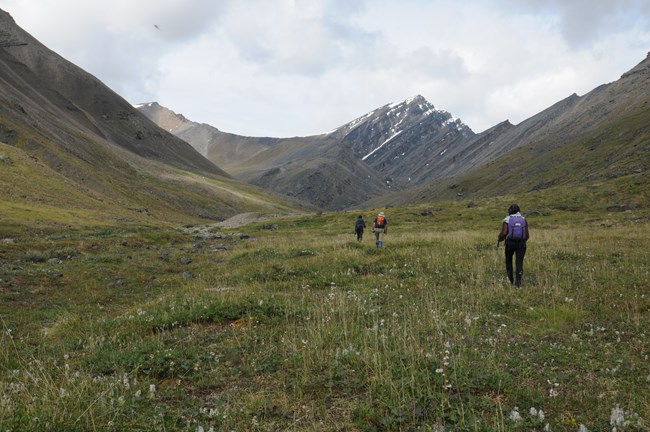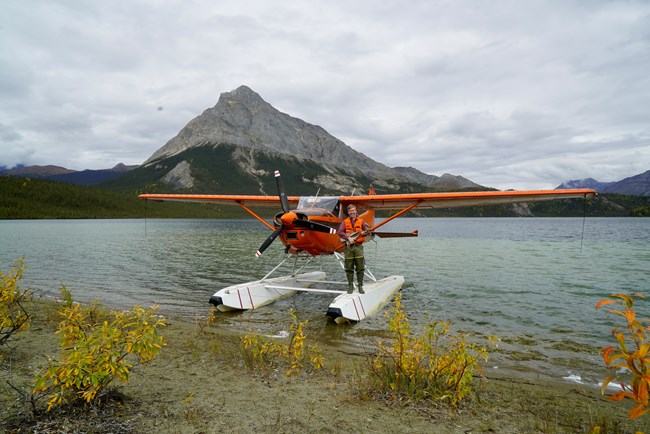|
As a wilderness park, there are no roads that enter Gates of the Arctic National Park and Preserve. Access to the park is by foot or by airplane.

NPS/Cadence Cook Accessing the Park by FootA backcountry trip into Gates of the Arctic National Park and Preserve can be a challenging and rewarding experience. Experienced hikers in the park consider six miles a good day's travel. There are no established trails, and the dense vegetation, tussocks, boggy ground and frequent stream and river crossings significantly slow your progress. If attempting to access the park from the Dalton Highway, be aware of private and native lands within the BLM corridor. Many drainages heading west from the Dalton are on the opposite side of the Koyukuk and Dietrich Rivers. The best hiking will be where ridges and stream drainages provide firm footing and forest thins to low-growing tundra. There are many rivers in this area and you are likely to have to cross one or more during your trip. Water levels fluctuate continuously due to weather conditions, but the highest levels are generally in the spring during run-off. Acccess to the preserve can be attempted from Galbraith Lake. Parking is available at the Bureau of Land Management Galbraith Lake campground. During high water, crossing the Itikmilak and Itkillik Rivers can be difficult. 
NPS/Eric Tidwell Accessing the Park via AirplaneDue to the wild country of Alaska, airplanes are often the only way to reach backcountry areas that offer superb remote recreational opportunities. Before contacting a charter company, there are some questions you must ask yourself about your trip:
If you are relying on air travel for your visit, be aware that air taxis are often times unable to fly in inclement weather. Bring a few extra days of food and allow for 'weather days' in your trip plan to accommodate poor weather. Air charter operators must have a permit to operate within Gates of the Arctic National Park and Preserve. Some may offer a list of commercial permit holders, which may be obtained from the individual agency offices. View services and contact information for authorized CUA Holders and concessioners in the park. The type of aircraft depends on a number of factors, including the number and weight of people in your party, the amount of gear, the length and condition of the landing area, weather conditions, and the aircraft available. The plane will be equipped for either a hard-ground, snow, or a water landing. A Cessna 185 can carry 2-3 passengers and gear, depending on the above factors. A Cessna 206-207 carries 3-5 people and gear. A PA-18 (cub or super cub) carries only one passenger but is best suited for short, rough landing areas. Pilots insist on lighter loads when operating out of shorter, rougher landing areas, so your party may require more flights for the pick-up than the drop-off. For your own safety, do not pressure the pilot into taking more weight than the aircraft can safely handle for existing conditions. Safety TipsSafety is the responsibility of everyone on the plane. As a passenger, you should be willing to ask questions in a polite way if you feel uncomfortable about something or have additional questions. This idea can be intimidating, but if you are uncomfortable about something there is probably a reason. It is important to act on those feelings and voice any concerns. The pilot may have a simple answer that restores your comfort level. Asking a question may be all it takes to refocus on safety and avoid a mishap with the flight. On the other hand, if the pilot's answer does not satisfy you, stick to your instinct and either insist of safe practices being followed, or postpone the flight. It is better to ask questions about a flight and avoid a potential tragedy. This is good “risk management,” in which the passenger has a key role. Bad weather is often a problem in Alaska, especially in coastal and mountainous areas. Your plans should allow for a delay on each end of the trip due to weather, while longer delays are certainly possible. Remember, the weather could be fine at your location but hazardous where the plane is based. If you feel uncomfortable about weather at any time, it is important to relay that information to the pilot. It is better to ask questions about a flight and avoid a potential tragedy. This is good “risk management,” in which the passenger has a key role.
It is imperative that there are no misunderstandings about where and when you should be picked up by the pilot, not only to maintain an agreed-upon price but for your own safety. The pilot should also be familiar with the landing area and certain that the plane can land there. Remember to discuss alternatives with the pilot in case the landing area becomes temporarily unusable. CostCheck with your operator for an estimate before you fly. Charter costs always include the pilot’s round-trip. Keep in mind that poor weather and/or wind can change the flight time. You can reduce costs by taking a scheduled commercial or mail flight to the community nearest to your destination and charter an aircraft from there. Aircraft may also be chartered directly from Fairbanks, which is more convenient but usually more expensive because of the longer distances and flying times involved. There may be weight restrictions depending on the type of aircraft you are using. Proper gear selection and efficient packing are also a good way to help reduce costs. Hazardous MaterialsIf you are carrying any red pepper-based (capsicum) aerosol sprays for bear protection, fuel, camp stoves, guns, and/or ammunition, be sure to notify the pilot. For safety reasons, the pilot may have special procedures for handling these materials Helicopter UseHelicopter landing in the park is prohibited except in an emergency involving public safety. Food CachesUnattended property such as food or gear caches that interfere with visitor safety, orderly management of the Park areas or presents a safety hazard will be impounded. Dropping or delivering food, equipment or supplies from air to ground is prohibited except in cases of emergency. A permit can be obtained if food, supplies or gear need to be cached for extended periods of time. All caches must be in a bear resistant container and labelled with date of caches and contact information. |
Last updated: March 24, 2023
